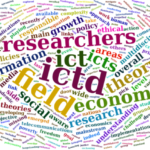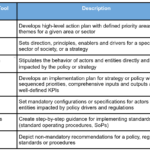I received yet another request for support on integrating ICTs into the UNDAF process, this time from Armenia. Here is my reply. The UNDAF documents are here: http://www.un.am/en/UNDAF
Although the UNDAF has four main priorities, on the other hand it has quite a few outcomes eh? In a way this is good as it allows us to cluster some of the ICTD activities.
There are some obvious entry point, as follows:
1. Under Outcome 1 (or national priority 1) we have output 1.1.2 on knowledge economy and innovation which surprisingly doesnot mention ICTs at all. On the other hand, this is the outcome more closely related to WSIS action plan. Being that as it may, three of the four indicators of this output are all focused on access to ICTs which is a good starting point. Indicators on household access are missing as well as indicators on use of ICTs such as number of online services accessed, number of requests for information, e-readiness index, e-government and e-participation indexes, etc.) Access to ICTs alone do not guarantee anything. Think mobiles and Armenia where mobile penetration is over 120%).
2. Output 1.1.2 can in any case be linked to outputs 1.1.3 on local producers and technology and 1.2.2 on vocational training, skills and knowledge. On the former, policies and standards that match EU standards for example need to be designed and deployed. And many of these involved sophisticated ICT applications and solutions that should be open and shareable to reduce cost and foster greater use and access. On 1.2.2, we cannot build a knowledge society if people in the country cannot master to use and appropriate ICTs. As the UNDAF says, Armenia has little natural resources so it should bet big time
on knowledge products to be competitive, e-capacities are thus fundamental to achieve these goals. And this almost by default links to output 1.1.3 on PPPs as the Private sector can play a key role here.
3. On the governance side (national priority 2), outcome 2.4 (with its four agency outcome) seems to be the best entry point as it is essentially focused on participation in decision making processes. While independent media is an agency outcome on its own, we cannot find ICTs anywhere (I already mention e-participation). In addition to the mobile penetration mentioned above, Armenia is one of the few countries where Facebook users is larger than Internet penetration (although this is still below 10%!) which means that people are using smartphones to connect and make their voices heard). Thus can
thus have great potential specially if we think about youth. On the media side, the outcome seems to center on traditional media and ignores the rapidly emerging new media which builds on ICTs and Web 2.0 technologies. And the indicator for this outcome reflects the traditional approach to media.
4. Outcome 2.4 is the demand side of the governance equation and thus complements outcome 2.2 which relates to transparency, accountability and inclusiveness. Here, it would have been a good idea to introduce the concept of e-governance as we use it in UNDP. That is, public investments on ICTs to foster transparency and accountability of public institutions and foster participation of people in decision making process. As you can see, e-governance cuts across the whole outcome 2.
5. The other core aspect of e-governance is its support for the provision of public services (e-services) which includes not only public documents and information but also social areas such as education and health -both integral part of outcome 3. There are already many examples on this, including EE. The key argument here is that ICTs not only lower the cost of the provision of such service and increase access but also provide a platform to scale up and accelerate their delivery.
Needless to say, this does not apply to ALL services (as ICTs are no panacea!)
6. ICTs are also important for sustainable development. Actually, this is how UNDP got involved in the area of ICT for development (please see my blog for an overview of this: https://www.undpegov.org/node/374).
I think all of the above can give you some good and solid ammunition to cluster outcomes around ICTs, rethink some of the indicators ans start thinking on the next UNDAF.
Cheers, Raúl





